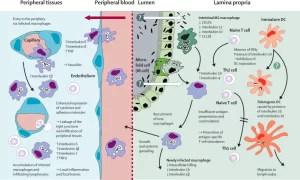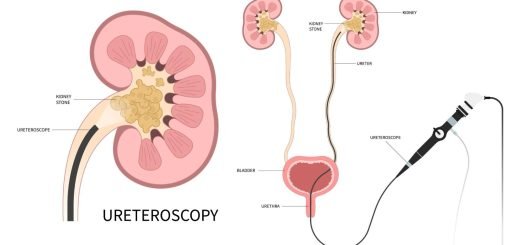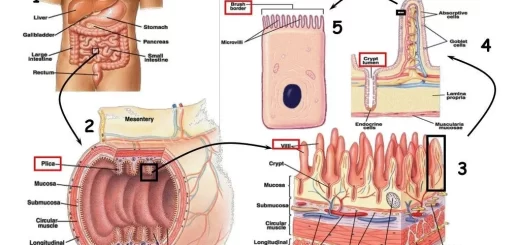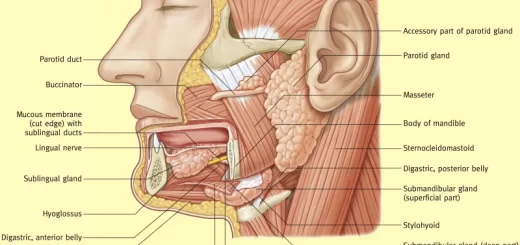Whipple’s disease symptoms, causes, treatment, and What organs are affected by Whipple?
Whipple’s disease is a rare systemic infection caused by the bacterium Tropheryma whippleii bacillus. It primarily affects the digestive system, but can also impact other organs like the heart, brain, joints, skin, and lungs. This bacterium is found in soil and water, but not everyone who comes into contact with it develops the disease.
Cause of Whipple’s disease
Chronic infection with Tropheryma Whippleii bacillus much System includes the small intestine. Its mucosa is infiltrated with macrophages full of periodic acid Schiff (PAS) positive material, with villi distortion.
Clinically:
Uncommon disease, due to infection by bacteria. Source of infection: unknown.
Age: adults
Clinical picture
A. GIT symptoms:
- Diarrhea.
- abdominal pain.
- distention.
- flatulence.
B. Other system:
- Polyarthritis migratory in nature, peripheral joints)
- Weight loss.
- Hypoalbuminemia.
- Low-grade fever.
- Generalized lymphadenopathy.
- Eye: uveitis, keratitis, retinal hemorrhage.
- C.N.S in 10%, dementia, fits, nystagmus, ophthalmoplegia.
Investigations
- Histological examination of endoscopic biopsy from the duodenum shows: PAS-positive macrophages that contain gram +ve bacilli.
- Lymph node biopsy.
- PCR shows 16 S ribosomal RNA of Tropheryma Whippleii (more sensitive test).
Treatment
Antibiotic therapy for one year (long duration) e.g. Sulfamethoxazole, Tetracyclines, Ceftriaxone.
Tropical Sprue
This is due to overgrowth of Coliforms in the jejunum with enterotoxin production, leading to villous atrophy with Malabsorption Syndrome.
Treatment
- 2 months of antibiotic therapy (tetracycline 250 mg/6 hours).
- Folic acid and B12.
Bacterial overgrowth
- Stasis syndrome.
- Blind loop syndrome.
- Overgrowth of bacteria within the small intestine leads to Malabsorption.
- Normally the small intestine may have a very small number of bacteria if this number increases to give malabsorption this syndrome is present.
- Clearing mechanism of organisms in the small intestine: Motility, Gastric acid secretion, Luminal immunoglobulin.
Mechanism of malabsorption
- Deconjugation of bile sal by bacteria.
- Bacteria produce toxic products, leading to mucosal damage.
- Malabsorption of CHO and bile acid increases their level in the colon, leading to Diarrhea.
- Bacteria itself take essential elements from the intestine leading to malabsorption of some nutrients such as Vit. B12.
- Disturbed CHO metabolism by gram -ve aerobes. Causes of this syndrome (Gastric causes, Pancreatic causes, Small intestine causes, Colon causes):
- Hypo or achlorhydria.
- Chronic Pancreatitis.
- Small intestinal: Bliroth II/diverticulosis, Surgical Blind Loop Syndrome.
- Fistula in the small intestine as in Crohn’s disease.
- Hypogammaglobulinemia.
- Motility disorders such as Diabetes and systemic sclerosis.
- Pseudo obstruction of the small intestine.
- Colonic anomalies with the small intestine or resection of the ileocecal valve.
Symptoms
- As that of malabsorption (Distention, Diarrhea, Loss of weight, Anemia).
- History of the cause if present.
Diagnosis
- Test of malabsorption.
- Take a sample from the upper part of the intestine by a tube for culture, Organisms> 100,000/ml are positive (gold standard).
- C13, C14 Xylose absorption test and detect isotopes in the breath (Collect CO2 with C14 or C13 in the breath as the bacteria split xylose and release CO2).
Treatment
- Antibiotics (Cephalosporins or Tetracycline) for 10 days.
- Octreotide to stimulate motility.
- Other nutritional therapy.
Small intestinal tumors
- They are less common; they are benign or malignant.
- In general, symptoms are:
- Vague abdominal pain.
- Bleeding.
- Intestinal obstruction.
- Melene.
- Anemia & Specific symptoms such as carcinoid syndrome.
- No symptoms.
Types
- Benign: Benign is usually asymptomatic unless bleeding occurs (Adenoma, Lipoma, Leiomyoma).
- Malignant: Adenocarcinoma: Ampulla’s of Vater is the common site. Sarcoma Leiomyosarcoma, Kaposi’s. They are presented with: Bleeding, Metastasis, and Obstruction.
Short Bowel Syndromeotams
- It is either absolute or relative.
- It depends upon the length lost from the intestine, the site of resection or loss, and the integrity of the rest of the intestines.
- The jejunum function can be all performed by the ileum if intact, but the reverse is not true.
- The TI if lost affects Vit. B12 deficiency and bile salt malabsorption lead to steatorrhea.
- Calcium oxalate stones occur if the colon is intact.
- Causes might be congenital or acquired. Congenital as in Midgut Volvulus, Omphalecel, JI atresia, or Congenital short bowel. Acquired as in surgical resection of part of the intestine, Intestinal ischemia, Radiation enteritis, or Crohn’s enteritis.
Management
- Nutritional therapy: Enteral nutrition, Parenteral nutrition.
- Specific therapy as octreotide.
Specific treatments for Malabsorption Disorders
- Celiac sprue: Gluten-free diet.
- Tropical sprue: Folate, B12, tetracycline.
- Collagenous sprue: Steroids
- Whipple’s disease: Penicillin G, streptomycin, TMP/SMX
- Lactase deficiency: Lactase supplementation.
- Other disaccharidase deficiencies: Dietary restriction.
- Bacterial overgrowth: Rotating antibiotics.
- Abetalipoproteinemia: Low-fat diet and fat-soluble vitamin supplementation.
- Lymphangiectasia: Correct causative disease, MCT.
- Crohn’s disease: Steroids, 5-aminosalicylates
- Eosinophilic enteritis: Steroids, cromolyn.
- Amyloidosis: Correct underlying process.
- Pancreatic insufficiency: Pancreatic enzymes.
- Short bowel syndrome: Medium-chain triglycerides, low-oxalate diet, TPN, PPI, GH, GLP-1.
- Giardia: Metronidazole, quinacrine.
- Isospora belli: TMP/SMX.
- Diphyllobothrium latum: Praziquantel.
- Strongyloidiasis stercoralis: Thiabendazole.
You can subscribe to Science Online on YouTube from this link: Science Online
You can download Science online application on Google Play from this link: Science online Apps on Google Play
Malabsorption syndrome causes, Symptoms, Treatment and How do you fix malabsorption syndrome?
Gastroesophageal reflux disease (GERD) cause, treatment, and How to treat eosinophilic esophagitis?
Pharynx function, anatomy, location, muscles, structure, and Esophagus parts
Tongue function, anatomy and structure, Types of lingual papillae and Types of cells in taste bud
Mouth Cavity divisions, anatomy, function, muscles, Contents of Soft palate and Hard palate
Temporal and infratemporal fossae contents, Muscles of mastication and Otic ganglion
Stomach parts, function, curvatures, orifices, peritoneal connections and Venous drainage of Stomach




